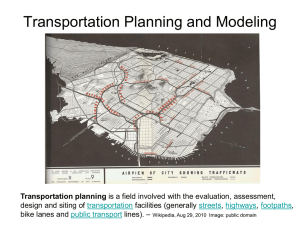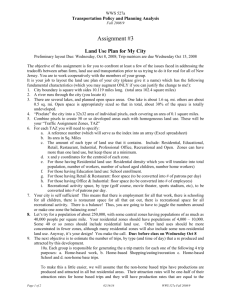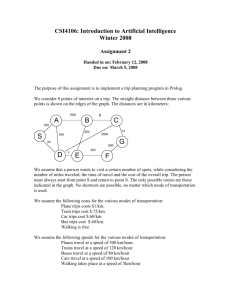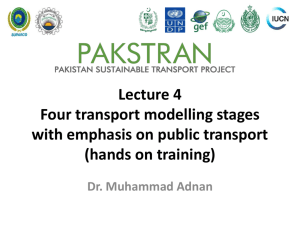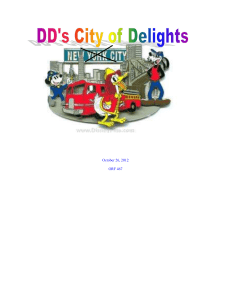Planning Process
advertisement
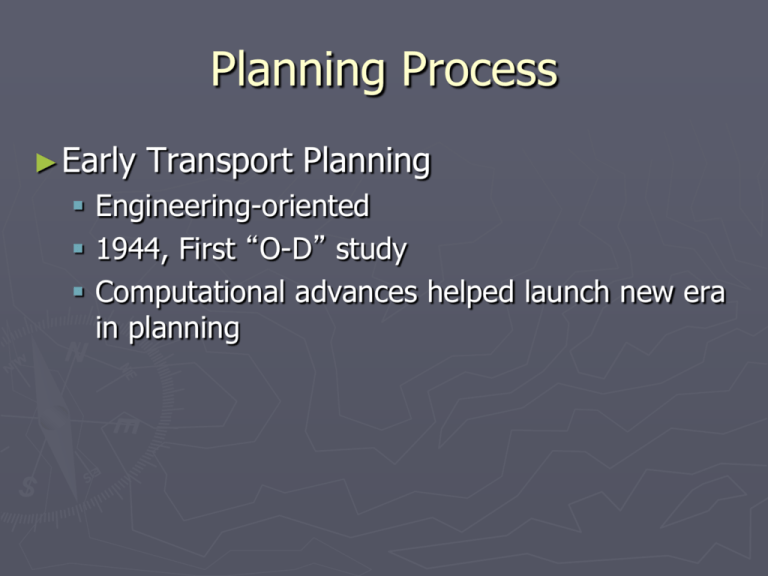
Planning Process ► Early Transport Planning Engineering-oriented 1944, First “O-D” study Computational advances helped launch new era in planning Planning Process ► Factors contributing to improved planning Rapid population growth Rapid car ownership growth Increased mobility More federal involvement in transportation Planning Process ► 1963 Federal Aid Highway Act Instituted “3C” process ►Continuing ►Comprehensive ►Cooperative Made federal funds contingent upon 3C process Planning Process ► Feds also acted as technical assistance Technology transfer Manuals and guides Creation of standards ►Planning ►Analysis ►Implementation Planning Process ► Federal involvement expanded What was just the Bureau of Public Roads soon became ►FHWA ►UMTA (now FTA) More requirements ►NEPA ►TSM ►TIP Planning Process ► Devolution in 1980s Feds became more or less “advisory” Mandates existed, but flexibility encouraged Planning didn’t change, transport patterns did Planning Process ► Federal resurgence Recognizing regional travel patterns ►Multi-jurisdictional a higher level solutions required involvement at Tied transportation plans to environmental planning ►Transportation plans could not contribute to the degradation of air quality Transportation and Land Development Cycle Increased Traffic Generation Increased Traffic Conflict Deterioration in Level-of-Service Land Use Change Arterial Improvements Increased Land Value Increased Accessibility Street Classification Street Classification Transportation Planning Process Pre-Analysis Phase •Problem/Issue Identification •Formulation of Goals and Objectives •Data Collection •Generation of Alternatives Technical Analysis Phase •Land Use Activity System Model •UTMS (or, UTPS; or UTPP) •Impact Prediction Models Post Analysis Phase •Evaluation of Alternatives •Decision Making •Implementation of Plan •Monitoring Transportation Planning Process ► Inputs land use activity system transportation system characteristics ► Outputs Quantity (volume) Quality (speed) ► U.T.M.S. Trip Generation Trip Distribution Mode Choice Trip Assignment Inputs for UTMS ► Transportation System Characteristics Layout of transportation network Speed, Directionality, Turn Restrictions ► Land Use Activity System Characteristics Region divided into “zones” Each zone has its own unique characteristics ►land use ►social and economic attributes Watauga County V/C Boone V/C 2 3 1 4 5 Urban Transportation Model System ► Trip Generation “How many trips?” Predicting quantity of travel to and from a piece of land Depends on characteristics of the land ►land use type and intensity ►socioeconomic characteristics of activities using the land Linear Regression for TG T = f (landuse, socialfactors, demographics) T = a + b1 c1 + b2 c 2 + b3 c 3 + b4 c 4 + c1 c2 c3 c4 Urban Transportation Model System ► Trip Distribution “Where do they go?” Links origins and destinations many from zone ‘a’ goes to all other zones? ►how many to zone ‘a’ comes from all other zones ►how Dependent upon: ►attractiveness of zone ►“friction”, or difficulty of travel Simple Gravity Model Pi Pj I ij = k b dij Tobler’s First Law of Geography: Everything is related to everything else, but near things are more related than distant things. Intervening Opportunities æaj ö tij = k ç ÷ è vj ø tij # of trips aj # of opportunities at destination vj # of intervening opportunities k calibrating constant Urban Transportation Model System ► Mode Choice “How do they travel?” Predicts the share of travel by mode ►auto ►transit Dependent upon ►cost of travel by mode ►socioeconomic characteristics Mode Choice Model ( Y) U (T,C,Y ) = - T - 5 C Variable Meaning Mode Time Cost T Travel Time (in hours) Drive 0.50 2.00 C Travel Cost (in dollars) Carpool 0.75 1.00 Y Annual Income (in 000’s) Bus 1.00 .75 Mode Drive Carpool Bus Y=40 Y=10 Urban Transportation Model System ► Trip Assignment “By what route?” Predicting what parts of the network will be used to travel between origin and destination Dependent upon: ►all alternative routes (and their attractiveness) distance travel time perceived safety Trip Assignment ► All or nothing Find shortest path for between two zones Load all trips on that path Trip Assignment ► Incremental Loading (feedback) Split total flow in to subsets (i.e, 5% samples) Find shortest path between zones Load first 5% of trips onto that path Re-analyze shortest path Load next 5% of trips onto that path Repeat until total flow is dispensed with Output of UTMS ► Quantity Volume of traffic on network ► Quality Flow of traffic on network Volume to Capacity Ratios (V/C) ► Traffic volume compared to the capacity of a segment of the network Different street classifications have different capacities ► v/c = 1: volume of traffic equals capacity ► v/c less than 1: capacity of street not met ► v/c greater than 1: traffic exceeds capacity Levels of Service (LOS) ►A ►D Free Flow High Density Flow ► Freedom of Choice ►B Stable Flow (I) ► Choice others slightly affected by ►C Stable Flow (II) ► Choice significantly affected by others ► Freedom to maneuver severely restricted ►E At or Near Capacity ► Unstable operations (small changes = large effects) ►F Breakdown Flow ► traffic approaching exceeds traffic exiting From: Route 228 Improvement Project – Pennsylvania DOT Impact Prediction Models the consequences of alternatives ► Using UTMS predictions as inputs to estimate: ► Assessing construction and operating costs energy consumption air quality noise levels accident rates Further Readings/Review ► Transportation ► Impact Models Models

